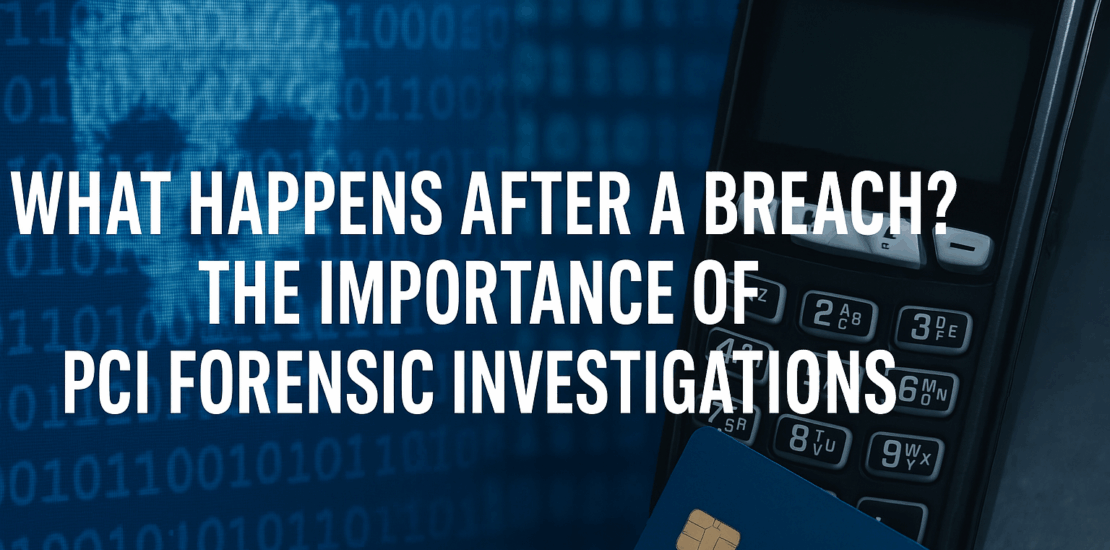What Happens After a Breach? The Importance of PCI Forensic Investigations
- April 29, 2025
- Posted by: Gradeon
- Categories: Compliance, IT Infrastructure

In today’s digital landscape, businesses that handle card payments and store customer data face an ever-evolving threat of data breaches. For UK businesses involved in card payment processing, IT infrastructure solutions, and customer data management, understanding the intricacies of PCI forensic investigations is paramount. This knowledge not only aids in swift breach response but also fortifies defences against future incidents.
The Importance of PCI Forensic Investigations
When a data breach occurs, especially one involving cardholder information, it’s crucial to determine the extent of the compromise, identify vulnerabilities, and implement measures to prevent recurrence. This is where PCI Forensic Investigators (PFIs) come into play. PFIs are qualified professionals authorised by the PCI Security Standards Council to conduct thorough investigations into cardholder data compromises. Their role includes:
- Identifying the Breach Source: Pinpointing how and where the breach occurred.
- Assessing the Compromise Scope: Determining the extent of data affected.
- Providing Remediation Guidance: Offering recommendations to prevent future breaches.
- Ensuring Compliance: Assisting businesses in aligning with PCI Data Security Standards (DSS).
Engaging a PFI promptly ensures that the investigation is conducted efficiently, preserving crucial evidence and maintaining compliance with industry regulations.
Navigating PCI DSS v4.0.1 Compliance in 2025
As of 31 March 2025, all businesses handling cardholder data must comply with PCI DSS version 4.0.1. This version introduces several updates aimed at enhancing payment security and providing greater flexibility for organisations. Key changes include:
- Enhanced Authentication Measures: Implementation of multi-factor authentication (MFA) for all access to the cardholder data environment is now mandatory. Previously a best practice, MFA is essential to protect against unauthorised access.
- Continuous Security Monitoring: Emphasis on security as an ongoing process, requiring regular testing and monitoring of security systems to promptly identify and address vulnerabilities.
- Flexible Implementation Approaches: Introduction of customised implementation options, allowing businesses to meet security objectives through methods tailored to their specific environments.
To ensure compliance:
- Conduct a Gap Analysis: Compare current security measures against PCI DSS v4.0.1 requirements to identify areas needing enhancement.
- Develop an Implementation Plan: Prioritise necessary changes, allocate resources, and set realistic timelines to achieve compliance by the March 2025 deadline.
- Engage Qualified Security Assessors (QSAs): QSAs can provide expert guidance, ensuring that implemented measures meet the required standards.
Best Practices for Protecting Your Business Post-Breach
Recovering from a data breach involves more than immediate damage control. Implementing robust security measures is essential to prevent future incidents. Consider the following best practices:
1. Strengthen Network Security
- Firewall Implementation: Deploy and maintain firewalls to monitor and control incoming and outgoing network traffic based on predefined security rules.
- Regular Network Segmentation: Divide networks into segments to isolate sensitive data, reducing the risk of widespread compromise.
2. Update Default Security Settings
- Change Default Passwords: Default credentials are widely known and easily exploitable. Ensure all default passwords are replaced with strong, unique ones.
- Configure Security Settings: Adjust default configurations of hardware and software to align with security best practices, minimising potential vulnerabilities.
3. Protect Cardholder Data
- Data Encryption: Encrypt cardholder data during transmission and storage to prevent unauthorised access.
- Data Masking: Display only the last few digits of the card number when necessary, obscuring the full number from unauthorised viewers.
4. Implement Multi-Factor Authentication (MFA)
- Strengthen Access Controls: Require multiple forms of verification for accessing sensitive systems, significantly reducing the risk of unauthorised access.
5. Regular Security Testing and Monitoring
- Vulnerability Scans: Conduct quarterly scans to identify and address security weaknesses.
- Penetration Testing: Perform annual tests simulating real-world attacks to evaluate the effectiveness of security measures.
6. Develop an Incident Response Plan
- Preparation: Establish a detailed plan outlining steps to take in the event of a breach, including roles and responsibilities.
- Regular Drills: Conduct periodic simulations to ensure staff are familiar with response procedures and can act swiftly during actual incidents.
The Role of IT Infrastructure in Data Security
For businesses offering IT infrastructure solutions—such as office relocation, on-site support, and network infrastructure services—maintaining robust security protocols is essential. These services often involve handling sensitive client data and integrating complex systems, making them potential targets for cyberattacks. To safeguard your operations and client trust:
- Secure Network Design: Implement network architectures that include segmentation, firewalls, and intrusion detection systems to protect against unauthorised access.
- Regular Security Audits: Perform comprehensive assessments of IT environments to identify vulnerabilities and ensure compliance with security standards.
- Employee Training: Educate staff on security best practices, recognising phishing attempts, and responding to potential threats.
